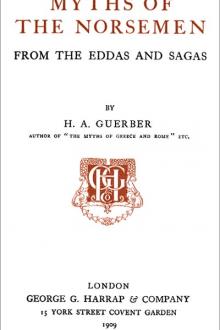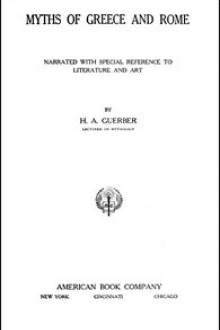Myths of the Norsemen, H. A. Guerber [ereader manga TXT] 📗

- Author: H. A. Guerber
- Performer: -
Book online «Myths of the Norsemen, H. A. Guerber [ereader manga TXT] 📗». Author H. A. Guerber
“There they stayed
Seven winters through;
But all the eighth
Were with longing seized;
And in the ninth
Fate parted them.
The maidens yearned
For the murky wood,
The young Alvit,
Fate to fulfil.”
Lay of Völund (Thorpe’s tr.).
The brothers felt the loss of their wives extremely, and two of them, Egil and Slagfinn, putting on their snow shoes, went in search of their loved ones, disappearing in the cold and foggy regions of the North. The third brother, Völund, however, remained at home, knowing all search would be of no avail, and he found solace in the contemplation of a ring which Alvit had given him as a love-token, and he indulged the constant hope that she would return. As he was a very clever smith, and could manufacture the most dainty ornaments of silver and gold, as well as magic weapons which no blow could break, he now employed his leisure in making seven hundred rings exactly like the one which his wife had given him. These, when finished, he bound together; but one night, on coming home from the hunt, he found that some one had carried away one ring, leaving the others behind, and his hopes received fresh inspiration, for he told himself that his wife had been there and would soon return for good.
The Ride of the Valkyrs
J. C. Dollman
By Arrangement with the Artist
That selfsame night, however, he was surprised in his sleep, and bound and made prisoner by Nidud, King of Sweden, who took possession of his sword, a choice weapon invested with magic powers, which he reserved for his own use, and of the love ring made of pure Rhine gold, which latter he gave to his only daughter, Bodvild. As for the unhappy Völund himself, he was led captive to a neighbouring island, where, after being hamstrung, in order that he should not escape, the king put him to the incessant task of forging weapons and ornaments for his use. He also compelled him to build an intricate labyrinth, and to this day a maze in Iceland is known as “Völund’s house.”
Völund’s rage and despair increased with every new insult offered him by Nidud, and night and day he thought upon how he might obtain revenge. Nor did he forget to provide for his escape, and during the pauses of his labour he fashioned a pair of wings similar to those his wife had used as a Valkyr, which he intended to don as soon as his vengeance had been accomplished. One day the king came to visit his captive, and brought him the stolen sword that he might repair it; but Völund cleverly substituted another weapon so exactly like the magic sword as to deceive the king when he came again to claim it. A few days later, Völund enticed the king’s sons into his smithy and slew them, after which he cunningly fashioned drinking vessels out of their skulls, and jewels out of their eyes and teeth, bestowing these upon their parents and sister.
“But their skulls
Beneath the hair
He in silver set,
And to Nidud gave;
And of their eyes
Precious stones he formed,
Which to Nidud’s
Wily wife he sent.
But of the teeth
Of the two
Breast ornaments he made,
And to Bödvild sent.”
Lay of Völund (Thorpe’s tr.).
The royal family did not suspect whence they came; and so these gifts were joyfully accepted. As for the poor youths, it was believed that they had drifted out to sea and had been drowned.
Brunhild and Siegmund
J. Wagrez
Photo, Braun, Clément & Co.
Some time after this, Bodvild, wishing to have her ring repaired, also visited the smith’s hut, where, while waiting, she unsuspectingly partook of a magic drug, which sent her to sleep and left her in Völund’s power. His last act of vengeance accomplished, Völund immediately donned the wings which he had made in readiness for this day, and grasping his sword and ring he rose slowly in the air. Directing his flight to the palace, he perched there out of reach, and proclaimed his crimes to Nidud. The king, beside himself with rage, summoned Egil, Völund’s brother, who had also fallen into his power, and bade him use his marvellous skill as an archer to bring down the impudent bird. Obeying a signal from Völund, Egil aimed for a protuberance under his wing where a bladder full of the young princes’ blood was concealed, and the smith flew triumphantly away without hurt, declaring that Odin would give his sword to Sigmund—a prediction which was duly fulfilled.
Völund then went to Alf-heim, where, if the legend is to be believed, he found his beloved wife, and lived happily again with her until the twilight of the gods.
But, even in Alf-heim, this clever smith continued to ply his craft, and various suits of impenetrable armour, which he is said to have fashioned, are described in later heroic poems. Besides Balmung and Joyeuse, Sigmund’s and Charlemagne’s celebrated swords, he is reported to have fashioned Miming for his son Heime, and many other remarkable blades.
“It is the mate of Miming
Of all swerdes it is king,
And Weland it wrought,
Bitterfer it is hight.”
Anglo-Saxon Poetry (Coneybeare’s tr.).
There are countless other tales of swan maidens or Valkyrs, who are said to have consorted with mortals; but the most popular of all is that of Brunhild, the wife of Sigurd, a descendant of Sigmund and the most renowned of Northern heroes.
William Morris, in “The Land East of the Sun and West of the Moon,” gives a fascinating version of another of these Norse legends. The story is amongst the most charming of the collection in “The Earthly Paradise.”
The story of Brunhild is to be found in many forms. Some versions describe the heroine as the daughter of a king taken by Odin to serve in his Valkyr band, others as chief of the Valkyrs and daughter of Odin himself. In Richard Wagner’s story, “The Ring of the Nibelung,” the great musician presents a particularly attractive, albeit a more modern conception of the chief Battle-Maiden, and her disobedience to the command of Odin when sent to summon the youthful Siegmund from the side of his beloved Sieglinde to the Halls of the Blessed.
Hel, goddess of death, was the daughter of Loki, god of evil, and of the giantess Angurboda, the portender of ill. She came into the world in a dark cave in Jötun-heim together with the serpent Iörmungandr and the terrible Fenris wolf, the trio being considered as the emblems of pain, sin, and death.
“Now Loki comes, cause of all ill!
Men and Æsir curse him still.
Long shall the gods deplore,
Even till Time be o’er,
His base fraud on Asgard’s hill.
While, deep in Jotunheim, most fell,
Are Fenrir, Serpent, and Dread Hel,
Pain, Sin, and Death, his children three,
Brought up and cherished; thro’ them he
Tormentor of the world shall be.”
Valhalla (J. C. Jones).
In due time Odin became aware of the terrible brood which Loki was cherishing, and resolved, as we have already seen, to banish them from the face of the earth. The serpent was therefore cast into the sea, where his writhing was supposed to cause the most terrible tempests; the wolf Fenris was secured in chains, thanks to the dauntless Tyr; and Hel or Hela, the goddess of death, was hurled into the depths of Nifl-heim, where Odin gave her power over nine worlds.
“Hela into Niflheim thou threw’st,
And gav’st her nine unlighted worlds to rule,
A queen, and empire over all the dead.”
Balder Dead (Matthew Arnold).
This realm, which was supposed to be situated under the earth, could only be entered after a painful journey over the roughest roads in the cold, dark regions of the extreme North. The gate was so far from all human abode that even Hermod the swift, mounted upon Sleipnir, had to journey nine long nights ere he reached the river Giöll. This formed the boundary of Nifl-heim, over which was thrown a bridge of crystal arched with gold, hung on a single hair, and constantly guarded by the grim skeleton Mödgud, who made every spirit pay a toll of blood ere she would allow it to pass.
“The bridge of glass hung on a hair
Thrown o’er the river terrible,—
The Giöll, boundary of Hel.
Now here the maiden Mödgud stood,
Waiting to take the toll of blood,—
A maiden horrible to sight,
Fleshless, with shroud and pall bedight.”
Valhalla (J. C. Jones).
The spirits generally rode or drove across this bridge on the horses or in the waggons which had been burned upon the funeral pyre with the dead to serve that purpose, and the Northern races were very careful to bind upon the feet of the departed a specially strong pair of shoes, called Hel-shoes, that they might not suffer during the long journey over rough roads. Soon after the Giallar bridge was passed, the spirit reached the Ironwood, where stood none but bare and iron-leafed trees, and, passing through it, reached Hel-gate, beside which the fierce, blood-stained dog Garm kept watch, cowering in a dark hole known as the Gnipa cave. This monster’s rage could only be appeased by the offering of a Hel-cake, which never failed those who had ever given bread to the needy.
“Loud bays Garm
Before the Gnipa cave.”
Sæmund’s Edda (Thorpe’s tr.).
Within the gate, amid the intense cold and impenetrable darkness, was heard the seething of the great cauldron Hvergelmir, the rolling of the glaciers in the Elivagar and other streams of Hel, among which were the Leipter, by which solemn oaths were sworn, and the Slid, in whose turbid waters naked swords continually rolled.
The Road to Valhalla
Severin Nilsson
Further on in this gruesome place was Elvidner (misery), the hall of the goddess Hel, whose dish was Hunger. Her knife was Greed. “Idleness was the name of her man, Sloth of her maid, Ruin of her threshold, Sorrow of her bed, and Conflagration of her curtains.”
“Elvidner was Hela’s hall.
Iron-barred, with massive wall;
Horrible that palace tall!
Hunger was her table bare;
Waste, her knife; her bed, sharp Care;
Burning Anguish spread her feast;
Bleached bones arrayed each guest;
Plague and Famine sang their runes,
Mingled with Despair’s harsh tunes.
Misery and Agony
E’er in Hel’s abode shall be!”
Valhalla (J. C. Jones).
This goddess had many different abodes for the guests who daily came to her, for she received not only perjurers and criminals of all kinds, but also those who were unfortunate enough to die without shedding blood. To her realm also were consigned those who died of old age or disease—a mode of decease which was contemptuously called “straw death,” as the beds of the people were generally of that material.
“Temper’d hard by frost,
Tempest and toil their nerves, the sons of those
Whose only terror was a bloodless death.”
Thomson.
Although the innocent were treated kindly by Hel, and enjoyed a state of negative bliss, it is no wonder that the inhabitants of the North shrank from the thought of visiting her cheerless abode. And while the men preferred to





Comments (0)